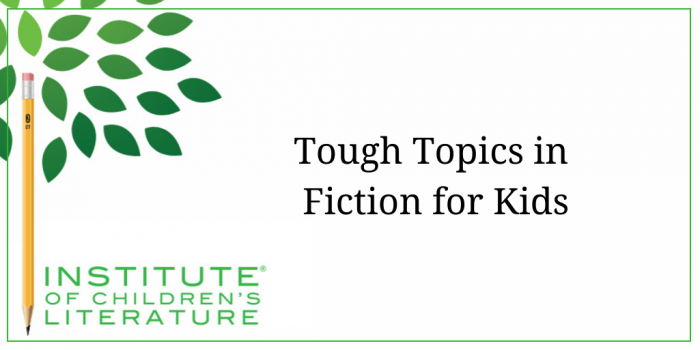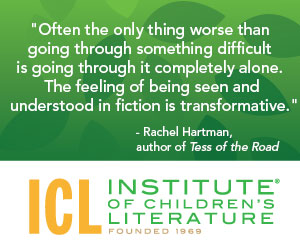1000 N. West Street #1200, Wilmington, DE 19801
© 2024 Direct Learning Systems, Inc. All rights reserved.

We teach our students how to write and get published!
View our Course Catalog >
Today, many children’s books do not take place in an idealized world where children are always loved, cared for, and healthy. Instead, some writers set their plots in worlds where children can suffer from abuse and homelessness. They sometimes tackle plots that include characters who are sick, even dying, or suffering from mental health problems or have family members who are suffering. The world of children’s books today is imperfect, reflecting the real world readers must live in. But tackling tough topics in fiction can be challenging to write, to sell, and to receive feedback about. Some adults are uncomfortable with books that tackle tough topics. They push back against them. So writers who tackle these topics clearly feel doing so is important, but why?
Some writers tackle these kinds of challenges because they want readers to gain empathy for and understanding of children who are in difficult situations. They believe that the more children are aware of the diverse situations found through the real world, the better prepared they will be to help. Other writers tackle challenging books because they want children in crisis to know they are not alone. Still others choose tough topics because they themselves lived through situations like that and are writing a book for the child they were. Many different people are drawn to books that dig deep and offer an unflinching look at real life. But what do writers need to know to tackle tough topics in children’s fiction? What is required?
Not All the Story Does
The first key to a successful fictional story is to make the book about more than the tough topics. For example, a story that includes a child with terminal cancer needs to be about more than the day in, day out medical care. The book needs to see the characters complexly and allow them to have a story that molds around the tough topic, but doesn’t limit itself to that. For example, a book with a very sick child might be about how that child helped another child or how that child went on an adventure. The characters in a quite famous young adult book with dying characters, The Fault in Our Stars by John Green, sends two teen characters with terminal cancer to another country where they experience adventure, conflict, and romance. They are still very sick, but they are also people who want to do things other than be sick.
Fully realized characters can come from all kinds of situations: loving families, broken families, lost families, and still function in a complex and exciting plot. Just as a book where children have what might be considered an “ordinary” situation isn’t just about that situation, so also a novel where children come from more complex situations can still have a plot that is about so much more. As author Fran Wilde says of her novel Riverland, “I didn’t want to write an issue book about domestic violence, necessarily. I wanted to write an adventure: one with two sisters as heroes and survivors.”

Willingness to Open Old Wounds
Making the story bigger than the tough topic doesn’t ignore the fact that the tough topic can be tough. A character dealing with racism can also be fighting monsters in his basement, but that doesn’t mean the racism doesn’t hurt or affect him. Tough topics aren’t simply crowbarred in, they must be emotionally true, and the emotional truth that makes a book with a challenging element work requires courage from the writer. If you don’t feel the book, the reader won’t find it emotionally true and won’t gain anything from your story.
Many writers who include tough topics in their work are doing so because the topic is either something they have lived or adjacent to something they have lived (where the emotional experience is one they can relate to). To successfully handle these tough topics, the writer must be able to feel them in a personal way, not simply feeling pity or even sympathy, but instead a place of shared emotional experience. So a character who is trapped in a painful situation might be experiencing a different kind of trap than the writer, but that feeling of frustration, hopelessness and pain needs to touch something the writer knows, and the writer must not shy away from writing from that place of struggle (or emotional memory of that place of struggle). Without a bold look at shared pain, the story will come out sounding shallow and unreal, which means that even if it sells, the reaction by those who actually experience the tough subject is likely to be negative.
Honest, Hopeful Solutions
When writing a difficult topic, writers can experience the deep longing to save the characters. This can be true if the situation is true to the writer’s life or not. Willingness to let our characters experience the actual suffering of life is not easy. But if you do write a solution, where the child ends up no longer experiencing abuse due to racism or no longer experiences domestic abuse from a mentally ill parent, the solution must be real and likely in order to be believable. It does the reader little good if the writer offers magical or simple answers. Unbelievable resolutions don’t offer hope, because a reader in crisis knows there is probably no magical solution waiting for him. So if the character is experiencing some sort of abuse, and a secondary character suddenly reveals he is an action hero and swoops in to rescue the main character, that might be emotionally satisfying for the author, but can easily leave the reader unsatisfied.
Sometimes a book with a tough situation ends with the character still in the situation. The character still has the medical condition or still has a mentally ill parent or still lives in a world where racism exists. Not all stories rescue the character at all. The key to a satisfying story is hope. The character dealing with racism has some kind of success overcoming a situation, but he knows another situation will come along. Still, he has the hope of knowing he will not be beaten down or defeated even though the situation is grossly unfair. And maybe he has hope for change, slow change, but some kind of change ahead. Whatever level of hope you build into the story, it must be a realistic hope. A realistic hope is honest and true, and it’s that kind of hope that can spread to the reader and offer the reader strength. And that makes for a book that is memorable.
Courageous Writing
One thing all writers of tough topics must face is that your story will not please everyone. Some people will be angry that dark topics are part of any story for young people. Some people will not like how you handled your subject. Some may have a problem with the subject being explored by you (which is why it’s important to really ask yourself why you are the person the write this story). Some schools may not let you come and speak because of something in your story. These are not comfortable things, and you should enter into the story knowing they can happen. And realistically, they will happen, at least once or twice, especially if your story becomes widely read. Because of these things, tough topics must be explored by writers with the courage to face the consequences. It can get hard, but if your reason for writing the book is strong enough, then that strength will get you through. Explore tough topics for the right reasons and with the right depth and you’ll offer something incredibly valuable to young readers, and that may be worth any blow back that may result. Only you can know for sure.
With over 100 books in publication, Jan Fields writes both chapter books for children and mystery novels for adults. She’s also known for a variety of experiences teaching writing, from one session SCBWI events to lengthier Highlights Foundation workshops to these blog posts for the Institute of Children’s Literature. As a former ICL instructor, Jan enjoys equipping writers for success in whatever way she can.
1000 N. West Street #1200, Wilmington, DE 19801
© 2024 Direct Learning Systems, Inc. All rights reserved.
1000 N. West Street #1200, Wilmington, DE 19801
© 2024 Direct Learning Systems, Inc. All rights reserved.
1000 N. West Street #1200, Wilmington, DE 19801
© 2024 Direct Learning Systems, Inc. All rights reserved.